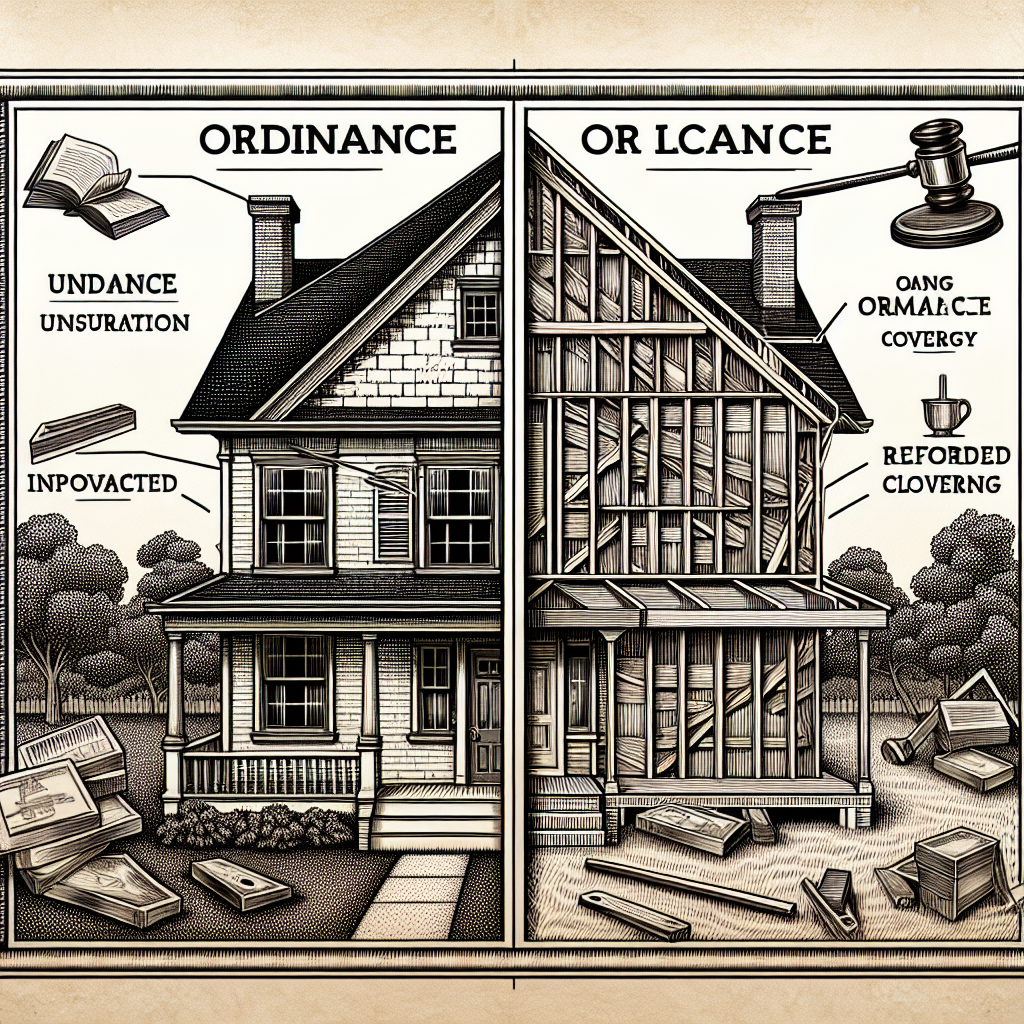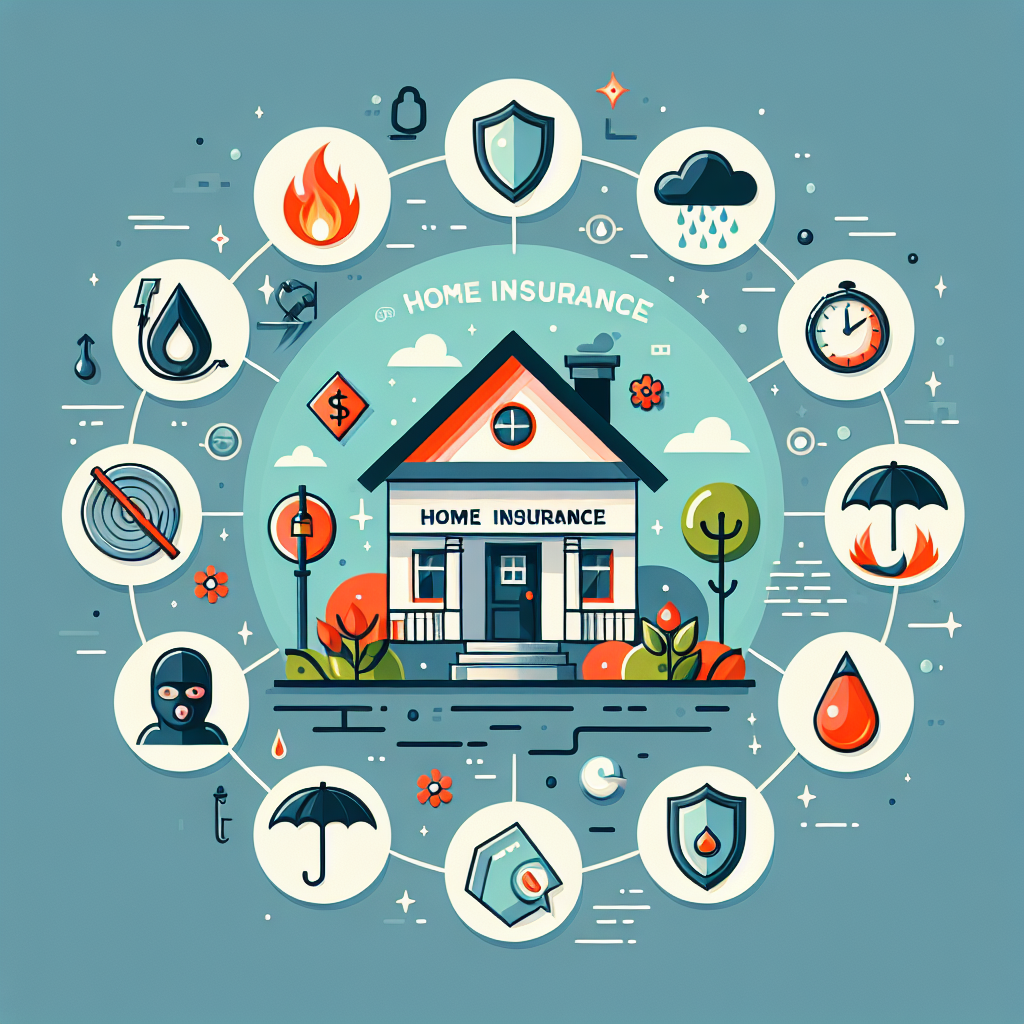Filed under Home Insurance on
Ordinance or Law Coverage in Home Insurance Explained

When a storm, fire, or burst pipe damages a home, most people expect their homeowners policy to pay for rebuilding what was lost. Fewer realize that local building codes and ordinances can add thousands of dollars to the bill—costs a standard policy may not fully cover. That’s where ordinance or law coverage comes in. This specialized protection helps pay for mandated upgrades and demolition if updated building rules require you to rebuild differently than before. Understanding how it works can be the difference between a manageable claim and a budget-busting surprise.
What is ordinance or law coverage?
Ordinance or law coverage is an add-on (sometimes built into newer policies) that pays for costs required to comply with current building codes when repairing or replacing covered property. This includes situations where an inspector says you must tear down undamaged portions, or when new codes demand upgraded electrical systems, roof attachments, fire-resistance ratings, or more robust structural components during reconstruction.
In the Insurance Services Office (ISO) homeowners program, this protection is often attached by endorsement, commonly referred to as HO 04 77 (the exact form and number can vary by state and insurer). While the base policy covers “like kind and quality,” local codes may not allow an exact replacement if your home was built to older standards. Ordinance or law coverage closes that gap by funding the difference between what you had and what the law now requires.
Why building codes matter more today
Modern codes evolve to improve safety, resiliency, and energy performance. After major catastrophes—wildfires in the West, hurricanes in the Southeast, severe convective storms across the Midwest—jurisdictions frequently strengthen requirements for roofing, wind resistance, ember-resistant vents, seismic bracing, or flood-resistant materials. The Insurance Institute for Business & Home Safety (IBHS) and public agencies like FEMA have long shown that homes built to stronger codes fare better and suffer less damage. That’s good for communities, but it can increase the cost of repairs when a partial loss triggers compliance.
At the same time, construction labor and materials have experienced persistent inflation in recent years. Industry analyses by large property data firms and contractor networks report higher costs for skilled trades, roofing materials, lumber, and electrical components. Those trends magnify code-related upgrades, because you are not just replacing damaged parts—you may be upgrading the entire affected system to current standards.
How the coverage typically works
Although details differ by insurer and state, ordinance or law coverage often breaks down into three main buckets, paralleling the structure commonly seen in ISO forms for both personal and commercial property:
1. Loss to the undamaged portion. If the building department requires you to tear down an undamaged section because a certain threshold of damage has been met, this portion helps pay for the value of the undamaged part you must demolish.
2. Demolition and debris removal. This covers the cost to demolish and dispose of materials, including undamaged sections, when required by code enforcement or an order from local authorities.
3. Increased cost of construction. This pays the difference between repairing with “like kind and quality” and reconstructing to meet current code—think stronger roof decking, additional fasteners, tempered glass near stairways, GFCI/AFCI electrical protection, upgraded insulation or wall assemblies, or new fire-rated doors between a garage and living space.
The combination of these three components is what most homeowners think of when they hear ordinance or law coverage. Some carriers bundle them under a single limit; others provide separate sublimits. Knowing your structure matters—during a claim, you don’t want to discover that you exhausted the demolition bucket but still need funds for code-mandated upgrades.
Is it included automatically?
Policies vary widely. Many modern HO-3 and HO-5 policies include a modest built-in sublimit—often around 10 percent of Coverage A (Dwelling)—with options to buy higher amounts. Other carriers require a specific endorsement to activate any protection at all. Because the wording and limits differ, it is essential to read your declarations page and endorsements or ask your agent exactly what you have.
How much coverage do you need?
There is no universal formula, but you can get close by combining local knowledge, your home’s characteristics, and your risk tolerance.
Consider the following factors:
Age and systems. Older homes are more likely to trigger electrical, plumbing, or structural upgrades during repair. A 1970s house with original wiring, galvanized pipes, or a noncompliant stair design may face significant code updates.
Jurisdictional thresholds. Some codes require full compliance when more than a certain percentage of the structure is damaged. If your city enforces a 50 percent rule, a major partial loss could force you to tear down the rest.
Hazard environment. In hurricane-prone regions, roof deck attachment and secondary water barriers may be required. In wildfire zones, ember-resistant vents and defensible space standards can apply. Seismic retrofits matter in quake-prone areas.
Design complexity. Custom architecture, tall walls, specialized glazing, or unique materials can magnify code upgrade costs. Historic districts may also introduce additional preservation requirements.
Market construction costs. Labor shortages and volatile material prices increase the cost of both demolition and upgrades.
Carrier options typically include limits of 10 percent, 25 percent, or 50 percent of Coverage A. Some insurers offer higher limits or even endorsement options intended to approximate “full” compliance, though practical caps and policy terms still apply. For many owners of newer tract homes in jurisdictions with moderate code demands, 25 percent can be a starting point. For older or historic homes, or for properties in strict code areas, 50 percent or more may be advisable. Ultimately, coordinate with a knowledgeable agent or broker who understands local building practices.
Real-world scenario: Why it matters
Imagine a fire damages the kitchen and part of the second floor. The building department determines that 45 percent of the structure is impacted and requires the undamaged portion of the second floor to be torn down to preclude unsafe tie-ins with modern framing requirements. The inspector then mandates upgraded electrical circuits with arc-fault protection, additional smoke alarms to current code, tempered glass near the stairwell, and changes to the egress window dimensions.
Your base policy pays to replace fire-damaged materials—cabinets, drywall, flooring. But if you lack ordinance or law coverage, you could be on the hook for the undamaged portion you had to demolish and the cost difference for each system upgrade. Depending on the home, that gap may run into tens of thousands of dollars.
Common misconceptions
It only applies when you rebuild the entire home. Not true. Code upgrades are often triggered by partial losses. You don’t have to lose the whole structure for local rules to kick in.
It pays for any home improvement. Incorrect. The coverage is limited to required changes mandated by law or ordinance at the time of loss. It does not fund elective upgrades or updates unrelated to the damage.
It covers zoning changes that reduce rebuildable square footage. Generally not. If your lot is now subject to different setbacks or height limits that prevent reconstructing the same size home, ordinance or law coverage typically won’t compensate for lost square footage due to zoning or land-use changes. This is a frequent point of confusion—ask your agent how your policy treats changes in zoning versus building codes.
What’s usually excluded
While policy forms differ, homeowners should expect some common boundaries:
Fines and penalties. If the city issues a fine for past noncompliance, this is typically excluded.
Undocumented or illegal work. Costs to correct unpermitted or substandard prior work may not be covered unless directly necessary for the insured repair and mandated by code.
Pollution, asbestos, or mold beyond specified sublimits. Environmental hazards often have separate or limited coverage.
Upgrades not required by law. If it’s optional or a good idea but not mandated, payment is unlikely.
Increased costs due to new building methods that are not mandated. If you choose premium materials or designs beyond code minimums, the extra cost is typically yours.
How to document and navigate a claim
Start with the inspection. Ask the adjuster and contractor to coordinate with local building officials early. The scope of repair should reflect what’s required, and the file should include the specific code sections driving each upgrade.
Get itemized estimates. Separate demolition of undamaged portions, debris removal, and increased cost of construction. Adjusters are more likely to approve properly categorized line items tied to documented code mandates.
Cite code references. If your electrician says arc-fault breakers are required, request a written note with the applicable code citation adopted by your jurisdiction. Building departments may provide correction notices listing exact code sections.
Track thresholds. Some jurisdictions apply different rules once damage exceeds a percentage of the structure or a valuation threshold. Document the calculations that push you over that line.
Mind your limits. If you have a combined 25 percent ordinance or law limit, and demolition costs are high, you may need to prioritize how the sublimit gets used. Your adjuster can explain your policy’s method for allocating those costs.
Older and historic homes: Special considerations
Vintage homes can be expensive to bring to current standards. Knob-and-tube wiring may need replacement. Lathe-and-plaster walls often require special handling. Windows might need safety glazing or egress changes. Even if you value preservation, a building official may require newer assemblies to ensure occupant safety.
Owners in designated historic districts face a two-sided squeeze: building codes on one side, preservation requirements on the other. While ordinance or law coverage can help with code-driven upgrades, it typically won’t reimburse for specialized preservation costs unless those costs are required to meet applicable codes. A frank conversation with your agent about higher limits—and perhaps a specialty policy for historic homes—can prevent unwelcome surprises.
Regional examples of code-driven costs
Coastal wind zones. In Florida and along the Gulf Coast, building codes often require improved roof deck attachment, secondary water barriers, and impact-rated openings in certain zones when substantial repairs occur. Each mandate raises costs beyond standard replacement.
Wildland-urban interface (WUI). In parts of California and the Mountain West, codes can require ember-resistant vents, noncombustible siding in certain clearances, or Class A roofing materials. Compliance can add materially to the cost of rebuilding damaged sections.
Seismic safety. West Coast and Intermountain states may require bolting, shear walls, or cripple wall bracing when significant repairs are undertaken, even if the original home didn’t have those elements.
Trends to watch
More jurisdictions adopting and enforcing modern codes. FEMA and national standards organizations continue to support broader code adoption, with studies indicating better disaster outcomes where codes are robust and enforced.
Rising reconstruction costs. While year-to-year changes fluctuate, many markets have seen higher contractor rates and material prices compared to five or ten years ago. That means the same percentage limit may buy less upgrade capacity over time.
Insurer product updates. Some carriers are increasing default ordinance or law sublimits or offering more flexible endorsement menus, especially in catastrophe-prone states. Others are tightening terms in challenging markets. Keep an eye on renewal changes.
How to choose a limit with confidence
Start with a rebuild cost estimate. Your Coverage A should already reflect a realistic replacement cost for your home. Confirm with your agent that it aligns with current local building costs and your home’s specifications.
Layer in code exposure. Ask a local contractor or building official which upgrades are commonly triggered during repairs. If they mention roof deck nailing patterns, energy code insulation standards, or electrical arc-fault breakers, get a rough sense of the cost differential per square foot.
Adjust for home age and complexity. Pre-1990 homes in strict jurisdictions often benefit from 25 to 50 percent limits. Newer homes with modest code changes might be well served at 10 to 25 percent. Custom or historic properties may warrant higher amounts.
Review sublimits versus pooled limits. If your insurer breaks the coverage into separate buckets, ensure each bucket is adequate. High demolition costs can drain a small sublimit quickly.
Revisit annually. Codes evolve. So do construction costs. At renewal, verify whether your ordinance or law coverage limit still feels right.
Questions to ask your agent or broker
Do I have ordinance or law coverage built in, or is it an optional endorsement? If optional, what are the available limits and how are they priced?
Is my limit a single pool or split into separate parts for undamaged portion, demolition, and increased cost of construction?
Are there exclusions for zoning or land-use changes that reduce rebuildable area? How does the policy treat variance requirements?
Do code upgrades apply only to the damaged area, or to the entire affected system as required by law?
How does the policy handle historic or custom features? Are there any special endorsements recommended for my property?
What documentation will the claims team need to approve code-related costs?
Businesslike steps to take before a loss
Conduct a quick code exposure review. Spend 30 minutes with a contractor, home inspector, or your city’s building department to ask which upgrades are commonly required during repairs.
Photograph systems and labels. Clear, date-stamped photos of electrical panels, HVAC tags, and roof coverings can help adjusters understand what existed pre-loss and what the code now requires.
Keep permits and inspection reports. If you have past permits showing partial upgrades, they can clarify which systems might need additional work to comply fully.
Update your coverage. If your research suggests substantial potential upgrades, increase your ordinance or law limit before renewal deadlines.
How claims typically get settled
Most homeowners policies settle covered dwelling losses on a replacement cost basis if you actually repair or replace. For code-driven costs, the insurer usually pays the lower of the amount you actually spend to comply or your ordinance or law sublimit. In practice, you may see payments in phases: an initial actual cash value amount, followed by supplemental payments as you incur code compliance costs and provide documentation.
Insurers generally do not pay for theoretical upgrades you never perform. If you decide to take a cash settlement and not rebuild, you may receive less than if you complete the work, especially for code-related items that only become payable once incurred.
What lenders and associations may require
Mortgage lenders sometimes review insurance adequacy during underwriting or periodic servicing, particularly for higher-value homes or when renovations are planned. Homeowners associations (HOAs) can also impose building standards that coexist with municipal codes. While HOA rules are not “laws,” officials may require compliance after a loss to approve architectural changes. Your policy won’t pay for HOA preference items beyond code, but being aware of both sets of rules helps avoid design conflicts.
An expert view: Why this coverage earns its keep
Consumer advocates and regulators like the National Association of Insurance Commissioners (NAIC) consistently remind homeowners that coverage A limits and endorsements should match local realities, not just national averages. Industry experts point out that code upgrades often provide meaningful resilience benefits—stronger roofs and fasteners, safer electrical systems, improved egress—that reduce future loss severity. In other words, ordinance or law coverage is not just a cost; it is an investment in bringing your home up to safer standards during necessary repairs.
Quick recap of the essentials
Ordinance or law coverage helps pay when building codes require you to tear down undamaged parts or rebuild to stronger standards after a covered loss.
It usually addresses three buckets: undamaged portion, demolition and debris removal, and increased cost of construction.
Typical limits range from 10 percent to 50 percent of Coverage A, with higher options available from some insurers.
Older homes, strict jurisdictions, and custom designs tend to need higher limits.
Documentation is everything. Estimates should clearly tie each upgrade to a specific code requirement in your jurisdiction.
Frequently asked questions
Does it cover upgrades to energy codes?
Yes, if your jurisdiction requires specific energy-efficiency measures during permitted repairs—like additional insulation or specific window ratings—those costs generally fall under increased cost of construction, subject to your limit. Elective upgrades above code are not covered.
What if the home is a total loss?
If the structure is a total loss, the undamaged portion coverage may be less relevant, but demolition and increased cost of construction can be significant. Some policies handle totals differently than partial losses. Confirm if your limit applies equally in both scenarios.
Will my premium increase if I add more coverage?
Increasing ordinance or law limits typically raises premium modestly relative to the protection it provides. Because this coverage addresses high-cost surprises, many homeowners consider the trade-off favorable. Your agent can model the cost impact for each limit tier.
How do I know if my city will require upgrades?
Ask your building department which code editions are adopted and what thresholds trigger full or partial compliance during repairs. Many departments provide handouts summarizing common upgrade triggers for roofing, electrical, windows, and structural components.
Does it pay if I choose to relocate instead of rebuild?
Most policies pay code-related costs only when incurred during repair or replacement of the damaged dwelling. If you purchase a different home, some benefits may not transfer. Review your policy’s loss settlement terms.
Final takeaways and next steps
No one plans to tangle with building code requirements after a fire or storm. But the reality is that many claims trigger upgrades that a standard policy wasn’t designed to absorb. Adding or increasing ordinance or law coverage is a straightforward way to protect your budget from these hidden costs.
Here is a practical path forward. First, confirm whether your current policy includes this coverage and at what limit. Second, ask a local contractor or building official about the most common code upgrades required during repairs in your area. Third, set your limit according to your home’s age, complexity, and local rules—often 25 to 50 percent for older or custom homes. Finally, keep documentation habits strong: permits, inspection reports, and itemized estimates are your best allies during a claim.
With a thoughtful review and the right endorsement in place, you can turn a potential budget shock into a manageable, well-planned upgrade that leaves your home safer and more resilient.
Key phrase check and why it matters
If you remember one term from this guide, make it ordinance or law coverage. Ask your agent if ordinance or law coverage is included by default, and whether your jurisdiction’s code changes suggest increasing ordinance or law coverage beyond the minimum. For many homeowners, adequately set ordinance or law coverage is the simplest way to avoid paying out-of-pocket for mandated upgrades. Before your next renewal, take ten minutes to confirm that ordinance or law coverage is active, appropriately limited, and clearly explained on your policy documents.





